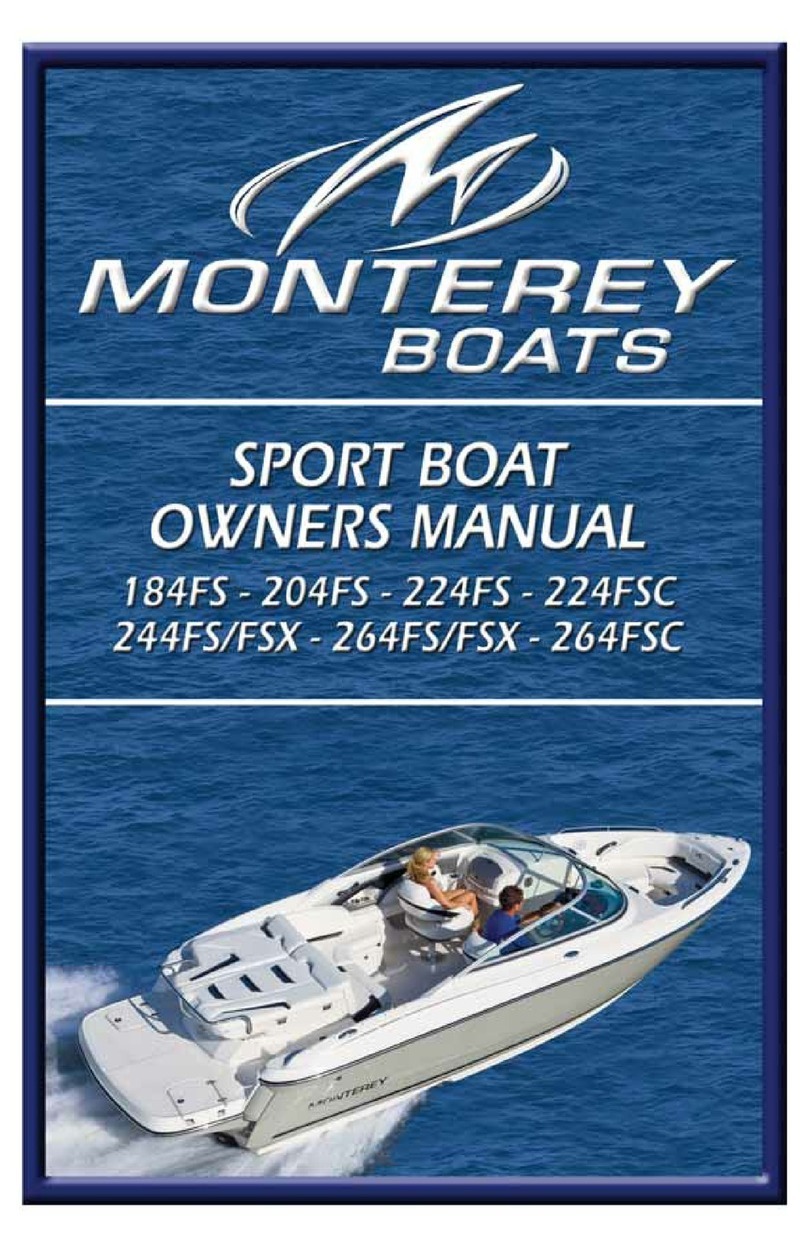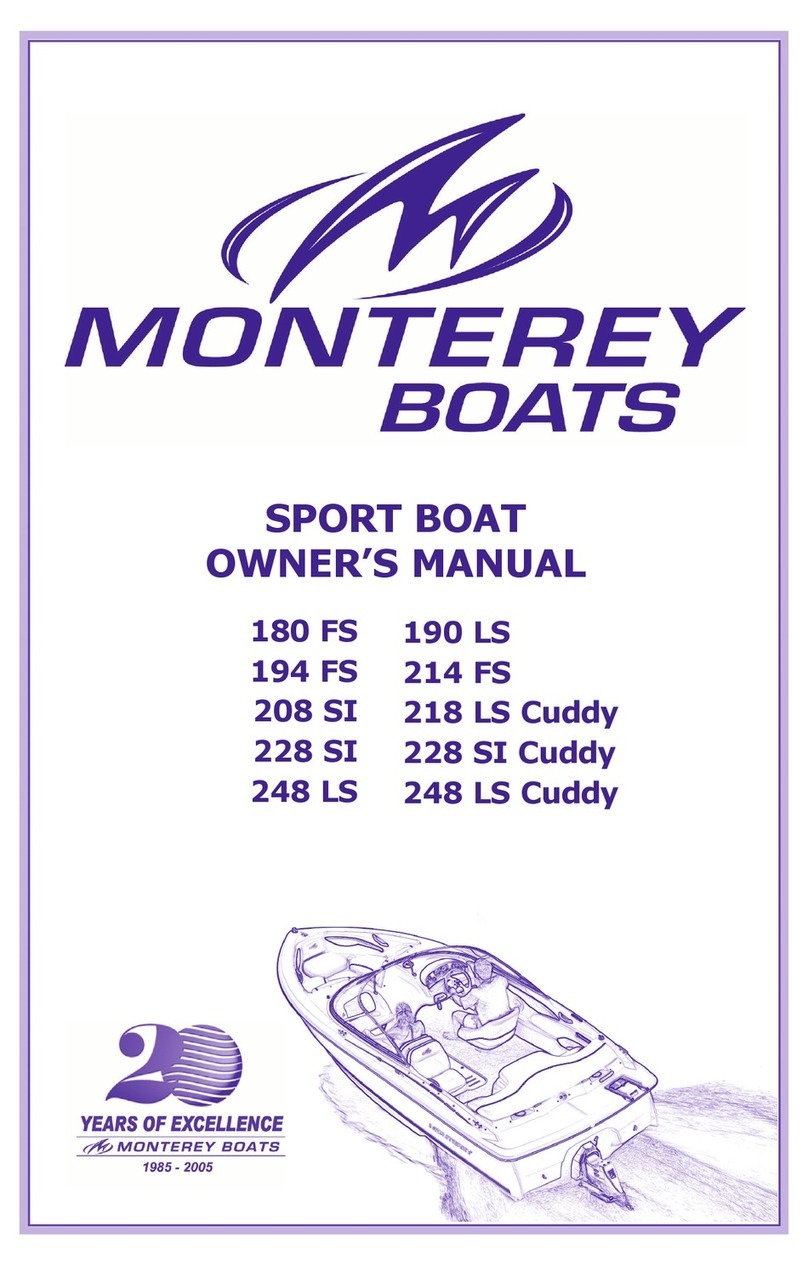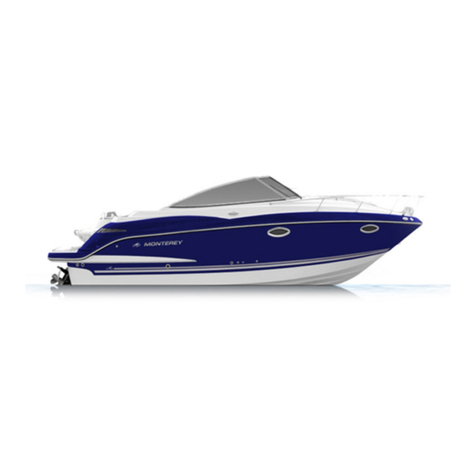SEABRING MARINE INDUSTRIES, INC. (MONTEREY BOATS)
warrants to the original retail purchaser of its products that the
boats manufactured by it will be free from defects in materials
and workmanship for one (1) year from the date of sale to the
original retail purchaser.
This warranty is extended to the original retail purchaser only
and does not apply to used boats, or to the following:
WHAT IS NOT COVERED:
This warranty does not cover:
1. Any boat that has been repaired or altered by persons other
than MONTEREY BOATS or an authorized MONTEREY
BOATS dealer, or modified in any way so as to affect its use
and operation;
2. Engines, outdrives, controls, batteries, propellers, any other
accessories or equipment that have been made by other
manufacturers, whether or not warranted by such other
manufacturers;
3. Gelcoat finish cracking, crazing or blistering;
4. Any boat used for racing or commercial purposes or that has
been subject to misuse, neglect, accident or structural
modification;
5. Windshield breakage, windshield leaks, hatch leaks, fuel
gauges and fuel gauge systems, fuel tanks and any defects in
paint, upholstery, canvas, vinyl, plastics fabrics, trim or other
materials;
6. Any boat that has been overpowered according to the
maximum BIA recommended engine horsepower specified
on the capacity plate affixed to said boat;
7. Installation of engines, generators, air conditioners, parts or
other after market accessories produced, installed or
attached by anyone other than MONTEREY BOATS;
8. Loss of time, inconvenience, loss of the use of the boat or
other matters not specifically covered hereunder; and
9. Any boat purchased by a consumer through an authorized
dealer located in the United States, which said boat is
registered and/or operated outside the United States.
FIVE-YEAR TRANSFERRABLE LIMITED STRUCTURAL HULL
WARRANTY:
Beginning with the 1999 model year boats, MONTEREY
BOATS also offers a Five-Year Transferrable Limited Structural
Hull Warranty. The Five-Year Limited Warranty may be
transferred to subsequent purchasers (hereinafter ‘new owner’)
for a fee of $50 for sport boats and $100 for cruisers. This
transfer will only apply during the five years from the date of
purchase to the original retail purchaser. Under the Five-Year
Transferrable Limited Structural Hull Warranty, MONTEREY
BOATS will repair or replace the fiberglass hull if it is found to
be structurally defective in materials or workmanship within the
first five years after purchase. For the purposes of this
warranty, the hull is defined as the single fiberglass casting
which rests in the water. This Five-Year Transferrable Limited
Structural Hull Warranty does not otherwise modify, expand or
affect the balance of the warranty provisions noted herein,
except as specifically noted.
1. The request for transfer must be made in writing by the new
owner and sent within thirty (30) days of the date of his/her
acquisition of the vessel to:
MONTEREY BOATS
1579 SW 18th Street
Williston, Florida 32696
2. `The request must include: A copy of the bill of sale with the
Hull ID number, the new owner’s name and address, and a
Certified Check or Money Order for the correct transfer fee
amount. MONTEREY BOATS will send a new warranty card
with the updated information once this information has been
received.
3. Only the unused portion of the original Five-Year
Transferrable Limited Structural Hull Warranty will apply to
the new owner.
4. In the event of fiberglass hull work is required, the new
owner must return the product to the original selling dealer
or to a dealer authorized to service MONTEREY products.
5. The cost of returning the product to and from either the
dealer, authorized representative or to MONTEREY BOATS
will be the sole responsibility of the owner.
GENERAL PROVISIONS:
MONTEREY BOATS does not authorize any person to create
or assume for it any other obligation or liability with respect to
its boats. No person, including a MONTEREY BOATS dealer, is
authorized to make any repairs or replacements under this
warranty without the prior written approval of MONTEREY
BOATS. MONTEREY BOATS’ obligation under this warranty is
limited to the cost of repair of the warranted item or
replacement thereof, at MONTEREY BOATS option. The sales
personnel or other employees of MONTEREY BOATS dealers
are not to make warranties concerning MONTEREY BOATS
products. MONTEREY BOATS shall have no obligation under
this written warranty unless and until each of the following
conditions are met:
1. The original retail purchaser of its product completes and
mails the Warranty Registration Card to MONTEREY BOATS
within thirty (30) days from the date of sale of the boat to
that purchaser;
2. Notice of each warranty claim is given to the MONTEREY
BOATS Dealer within a reasonable period of time after
discovery of any claimed defect;
3. Notice of each warranty claim is given to the MONTEREY
BOATS Dealer within (1) year from the date of purchase by
the original retail purchaser; and
4. All transportation charges incurred in transporting the boat
for warranty work are paid for by the owner.
THERE ARE NO WARRANTIES EXTENDED BEYOND THE
DESCRIPTION ON THE FACE HEREOF. ALL IMPLIED
WARRANTIES, INCLUDING WARRANTIES OF MER-
CHANTABILITY, FITNESS FOR PARTICULAR PURPOSE, OR
OTHERWISE ARE DISCLAIMED FOR THERE ENTIRETY AFTER
THE EXPIRATION OF THE ONE-YEAR WARRANTY.
MONTEREY BOATS SHALL NOT BE RESPONSIBLE FOR ANY
INCIDENTAL OR CONSEQUENTIAL DAMAGES OR LOSSES
RESULTING FROM A BREACH OF THIS WARRANTY OR ANY
IMPLIED WARRANTY.
Some states do not allow exclusions or limitations of
incidental or consequential damages, and some states do not
allow limitation on how long an implied warranty lasts, so the
above limitations or exclusions may not apply to you. This
warranty gives you specific rights, and you also may have other
rights that vary from state to state.
MONTEREY BOATS reserves the right to make changes at any
time, without notice, in prices or to make changes in colors,
specifications, equipment, options, materials, etc., and
MONTEREY BOATS shall be under no obligation to equip or
modify boats built prior to such changes.
IMPORTANT: Return of the Warranty Card to MONTEREY
BOATS is important for purposes of recording customer
information for notification and correction of product defects
under the Federal Boat Safety Act.
P.O. Box 818 • Williston, Florida 32696
(352) 529-9181 • FAX: (352) 529-9173
ONE-YEAR LIMITED AND FIVE-YEAR TRANSFERRABLE LIMITED
STRUCTURAL HULL WARRANTY ON NEW MONTEREY BOATS
Monterey Sport O/M Y2K 10/5/01 9:53 AM Page IRC1




































